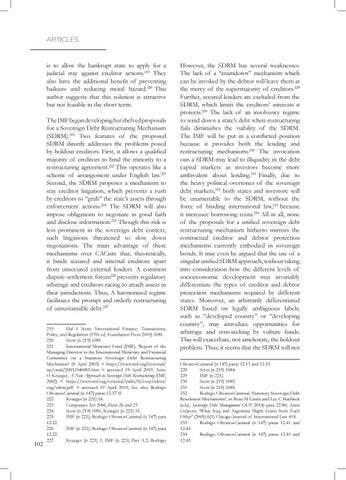ARTICLES
is to allow the bankrupt state to apply for a judicial stay against creditor actions.219 They also have the additional benefit of preventing bailouts and reducing moral hazard.220 This author suggests that this solution is attractive but not feasible in the short term. The IMF began developing but shelved proposals for a Sovereign Debt Restructuring Mechanism (SDRM).221 Two features of the proposed SDRM directly addresses the problems posed by holdout creditors. First, it allows a qualified majority of creditors to bind the minority to a restructuring agreement.222 This operates like a scheme of arrangement under English law.223 Second, the SDRM proposes a mechanism to stay creditor litigation, which prevents a rush by creditors to “grab” the state’s assets through enforcement actions.224 The SDRM will also impose obligations to negotiate in good faith and disclose information.225 Though this risk is less prominent in the sovereign debt context, such litigations threatened to slow down negotiations. The main advantage of these mechanisms over CACisre that, theoretically, it binds secured and internal creditors apart from unsecured external lenders. A common dispute settlement forum226 prevents regulatory arbitrage and creditors racing to attach assets in their jurisdictions. Thus, A harmonised regime facilitates the prompt and orderly restructuring of unsustainable debt.227
102
219 Hal S Scott, International Finance: Transactions, Policy, and Regulation (17th ed, Foundation Press 2010) 1081. 220 Scott (n 219) 1081. 221 International Monetary Fund (IMF), ‘Report of the Managing Director to the International Monetary and Financial Committee on a Statutory Sovereign Debt Restructuring Mechanism’ (8 April 2003) < https://www.imf.org/external/ np/omd/2003/040803.htm > accessed 19 April 2019; Anne O Krueger, A New Approach to Sovereign Debt Restructuring (IMF, 2002) < https://www.imf.org/external/pubs/ft/exrp/sdrm/ eng/sdrm.pdf > accessed 19 April 2019; See also, Rodrigo Olivares-Caminal (n 147) paras 12.17 ff. 222 Krueger (n 221) 14. 223 Companies Act 2006, Parts 26 and 27. 224 Scott (n 219) 1081; Krueger (n 221) 15. 225 IMF (n 221); Rodrigo Olivares-Caminal (n 147) para 12.22. 226 IMF (n 221); Rodrigo Olivares-Caminal (n 147) para 12.22. 227 Krueger (n 221) 1; IMF (n 221) Part A.2; Rodrigo
However, the SDRM has several weaknesses. The lack of a “cramdown” mechanism which can be invoked by the debtor will leave them at the mercy of the supermajority of creditors.228 Further, secured lenders are excluded from the SDRM, which limits the creditors’ interests it protects.229 The lack of an insolvency regime to wind down a state’s debt when restructuring fails diminishes the viability of the SDRM. The IMF will be put in a conflicted position because it provides both the lending and restructuring mechanisms.230 The invocation oan a SDRM may lead to illiquidity in the debt capital markets as investors become more ambivalent about lending.231 Finally, due to the heavy political overtones of the sovereign debt markets,232 both states and investore will be unamenable to the SDRM, without the force of binding international law,233 because it increasee borrowing costs.234 All in all, none of the proposals for a unified sovereign debt restructuring mechanism hitherto mirrors the contractual creditor and debtor protection mechanisms currently embodied in sovereign bonds. It may even be argued that the use of a singular unified SDRM approach, without taking into consideration how the different levels of socioeconomic development may invariably differentiate the types of creditor and debtor protection mechanisms required by different states. Moreover, an arbitrarily differentiated SDRM based on legally ambiguous labels, such as “developed country” or “developing country”, may introduce opportunities for arbitrage and rent-seeking by vulture funds. This will exacerbate, not ameliorate, the holdout problem. Thus, it seems that the SDRM will not Olivares-Caminal (n 147) paras 12.17 and 12.19. 228 Scott (n 219) 1084. 229 IMF (n 221). 230 Scott (n 219) 1085. 231 Scott (n 219) 1085. 232 Rodrigo Olivares-Caminal, ‘Statutory Sovereign Debt Resolution Mechanisms’, in Rosa M Lastra and Lee C Buchheit (eds), Sovereign Debt Management OUP 2014) para 22.80; Anna Gelpern, ‘What Iraq and Argentina Might Learn from Each Other’ (2005) 6(1) Chicago Journal of International Law 414. 233 Rodrigo Olivares-Caminal (n 147) paras 12.41 and 12.43. 234 Rodrigo Olivares-Caminal (n 147) paras 12.41 and 12.43.
